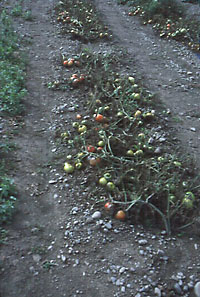Tools for Combating Late Blight
List of Tables Below
- Relative resistances of selected tomato cultivars to late blight in a trial conducted by Pia Gavino in the Fry Lab (1995)
- Relative resistances of several heirloom tomato
cultivars
in trials conducted by Hilary Mayton in the Fry Lab. - Cultivar Resistance (Potatoes)
- Relative efficacy of “alternative” late blight control
agents
in replicated trials conducted by Hilary Mayton in the Fry Lab

